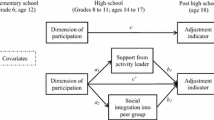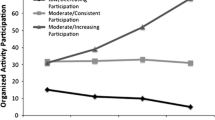Abstract
A psychosocial conception of ego strengths is presented in relation to adolescent involvement in adult-sponsored structured youth activities. Five-hundred and seventeen high school students completed measures on their involvement in structured activities and on 8 ego strengths. Gender, age, and SES were controlled in a MANCOVA procedure and it was found that extracurricular activities of sports, student government, and belonging to an issues group, as well as engagement in volunteerism were related to several of the ego strengths. Religious attendance was not related to the ego strengths. In longitudinal analysis, it was shown that ego strength at Time 1 predicted involvement in structured activities at Time 2 (8 months later), but structured activities at Time 1 did not predict ego strength at Time 2. The findings are discussed relative to theory and research findings on the topic.
Similar content being viewed by others
References
Adams, G. R., and Marshall, S. K. (1996). A developmental social psychology of identity: Understanding the person-in-context. J. Adolesc. 19: 429–442.
Benson, P. L., Donahue, M. J., and Erickson, J. A. (1989). Adolescence and religion: A review of the literature from 1970 to 1986. Res. Soc. Sci. Study Religion 1: 153–181.
Benson, P. L., Williams, D. L., and Johnson, A. L. (1987). The Quicksilver Years: The Hopes and Fears of Young Adolescents. Jossey-Bass, San Francisco.
Blum, R. W., and Rinehart, P. M. (1997). Reducing the Risk: Connections That Make a Differences in the Lives of Youth. University of Minnesota Printing Services, Minneapolis, MN.
Booth, J., and Martin, J. E. (1998). Spiritual and religious factors in substance use, dependence, and recovery. In Koenig, H. G. (ed.), Handbook of Religion and Mental Health. Academic Press, San Diego, CA, pp. 175–200.
Clark, P. (1995). Risk and resilience in adolescence: The current status of research on gender differences. Equity Issues, 1 Columbus, Ohio: The Ohio State University, Department of Home Economics Education.
Coleman, J. S. (1988). Social capital in the creation of human capital. Am. J. Sociol. 94(Suppl. 95): S95–S120.
De Haan, L. G., and Schulenberg, J. (1997). The covariation of religion and politics during the transition to young adulthood: Challenging global identity assumptions. J. Adolesc. 20: 537–552.
Donahue, (February, 1994). Positive Youth Development in Religiously-Based Youth Programs. Paper presented at the Meetings of the Society for Research on Adolescence, San Diego, CA.
Dworkin, J. B., Larson, R., and Hansen, D. (2003). Adolescents’ accounts of growth experiences in youth activities. J. Youth Adolesc. 32: 17–26.
Eccles, J. S., and Barber, B. L. (1999). Student council, volunteering, basketball, or marching band: What kind of extracurricular involvement matters? J. Adolesc. Res. 14: 10–43.
Erikson, E. H. (1968). Identity: Youth and crisis. W.W. Norton, New York.
Erikson, E. H. (1964). Insight and Responsibility. W.W. Norton, New York.
Erikson, E. H. (1965). Youth: Fidelity and diversity. In Erikson, E. H. (ed.), The Challenge of Youth. Anchor Books, Garden City, NY, pp. 1–28.
Erikson, E. H. (1985). The Life Cycle Completed. Norton, New York.
Erikson, E. H. (1987a). The human life cycle (1968). In Schlein, S. S. (ed.), A Way of Looking at Things: Selected Papers From 1930 to 1980. Norton, New York: pp. 595–610.
Erikson, E. H. (1987b). On protest and affirmation (1972). In Schlein, S. S. (ed.), A Way of Looking at Things: Selected Papers from 1930 to 1980 Norton New York, pp. 699–705.
Furstenberg, F. F., and Hughes, M. E. (1995). Social capital and successful development among at-risk youth. J. Marriage Fam. 57: 580–592.
Glanville, J. L. (1999). Political socialization or selection? Adolescent extracurricular participation and political activity in early adulthood. Soc. Sci. Q. 80: 279–290.
Gordon, E. W., and Song, L. D. (1994). Variations in the experience of resilience. In Wang, M. C., and Gordon, E. W. (eds.), Educational Resilience in Inner-City America: Challenges and Prospects. Erlbaum, Hillsdale, NJ, pp. 27–43.
Greeley, A. (1997). Coleman revisited: Religious structures as a source of social capital. Am. Behav. Sci. 40: 587–594.
Holland, A., and Andre, T. (1987). Participation in extracurricular activities in secondary school: What is known, what needs to be known? Rev. Educ. Res. 57: 437–466.
Johnson, M. K., Beebe, T., Mortimer, J. T., and Snyder, M. (1998). Volunteerism in adolescence: A process perspective. J. Res. Adolesc. 8: 309–332.
Jöreskog, K. G., and Sörbom, D. (1993a). LISREL 8 User’s Reference Guide. Scientific Software International, Inc., Chicago, IL.
Jöreskog, K. G., and Sörbom, D. (1993b). PRELIS 2 User’s Reference Guide. Scientific Software International, Inc., Chicago, IL.
Larson, R. (1994). Youth organizations, hobbies, and sports as developmental contexts. In Silbereisen, R. K., and Todt, E. (eds.), Adolescence in Context: The Interplay of Family, School, Peers, and Work in Adjustment. Springer-Verlag, New York, pp. 46–65.
Larson, R. W. (2000). Toward a psychology of positive youth development. J. Am. Psychol. 55: 170–183.
Leigh, G. K., and Bechtold, D. (1997). An Expanding View of Community Resiliency. Paper presented at the Theory and Construction and Research Methodology Workshop as part of the Annual Meeting of the National Council on Family Relations, Alexandria, VA.
Mahoney, J. L. (2000). School extracurricular activity participation as a moderator in the development of antisocial patterns. Child Dev. 71: 502–516.
Mahoney, J. L., and Cairns, R. B. (1997). Do extracurricular activities protect against early school dropout? Dev. Psychol. 33: 241–253.
Markstrom-Adams, C., Hofstra, G., and Dougher, K. (1994). The ego virtue of fidelity: A case for the study of religion and identity formation in adolescence. J. Youth Adolesc. 23: 453–469.
Markstrom, C. A. (1999). Religious involvement and adolescent psychosocial development. J. Adolesc. 22: 205–221.
Markstrom, C. A., and Marshall, S. K. (2004). The psychometric properties of the Psychosocial Inventory of Ego Strengths for high school students. Manuscript submitted for publication.
Markstrom, C. A., Sabino, V. M., Turner, B., and Berman, R. C. (1997). The Psychosocial Inventory of Ego Strengths: Development and assessment of a new Eriksonian measure. J. Youth Adolesc. 26: 705–732.
Moore, C. W., and Allen, J. P. (1996). The effects of volunteering on the young volunteer. J. Prim. Prev. 17: 231–258.
Nakao, K., and Treas, J. (1992). The 1989 Socioeconomic Index of Occupations: Construction from the 1989 Occupational Prestige Scores NORC, Chicago.GSS Methodological Report No. 74.
Newton, K. (1997). Social capital and democracy. Am. Behav. Sci. 40: 575–586.
Roth, J., and Brooks-Gunn, J. (2000). What do adolescents need for healthy development? Implications for youth policy. Soc. Policy Rep. 14, 3–19.
Schlegel, A., and Barry, H.III (1991). Adolescence: An Anthropological Inquiry. The Free Press, New York.
Silliker, S. A., and Quirk, J. T. (1997). The effect of extracurricular activity participation on the academic performance of male and female high school students. Sch. Counsel. 44: 289–293.
Stevens, J. (1996). Applied Multivariate Statistics for the Social Sciences 3rd edn. Erlbaum, Hillsdale, NJ.
Thomas, D. L., and Carver, C. (1990). Religion and adolescence social competence. In Gullotta, T. P., Adams, G. R., and Montemayor, R. (eds.), Developing Social Competency in Adolescence. Sage, Newbury Park, CA, pp. 195–219.
Tzuriel, D. (1984). Sex role typing and ego identity in Israeli, Oriental, and Western adolescents. J. Pers. Soc. Psychol. 46: 440–457.
Wallace, J. M.Jr. and Forman, T. A. (1998). Religion’s role is promoting health and reducing risk among American youth. Health Educ. Behav. 25: 721–741.
Werner, E. E., and Smith, R. S. (1982). Vulnerable but Invincible: A Longitudinal Study of resIlient Children and Youth. McGraw-Hill, New York.
Yates, M., and Youniss, J. (1996). Community service and political-moral identity in adolescents. J. Res. Adolesc. 6: 271–284.
Youniss, J., McLellan, J. A., Su, Y., and Yates, M. (1999a). The role of community service in identity development: Normative, unconventional, and deviant orientations. J. Adolesc. Res. 14: 248–261.
Youniss, J., McLellan, J. A., and Yates, M. (1997a). What we know about engendering civic identity. Am. Behav. Sci. 40: 620–631.
Youniss, J., McLellan, J. A., and Yates, M. (1999b). Religion, community service, and identity in American youth. J. Adolesc. 22: 243–253.
Youniss, J., Yates, M., and Su, Y. (1997b). Social integration: Community service and marijuana use in high school seniors. J. Adolesc. Res. 12: 245–262.
Zoerink, D. A., Magafas, A. H., and Pawelko, K. A. (1997). Empowering youth at risk through community service. Child Youth Care Forum 26: 127–138.
Author information
Authors and Affiliations
Corresponding author
Additional information
Carol A. Markstrom is a Professor in Family and Consumer Sciences, West Virginia University. She received her Ph.D. in Developmental Psychology in 1988 from Utah State University. Her research interests include adolescent identity formation, positive youth development, American Indian adolescents, and indigenous models of human development.
Xaioming Li is a Professor, Department of Pediatrics, Wayne State University. He received his Ph.D. in Educational Psychology in 1992 from the University of Minnesota. Research interests (in general) include child development, adolescent health risk prevention and intervention, research methodology, and biostatistics.
Shana L. Blackshire is a M. S. Instructor, Child Development and Family Studies, Division of Family and Consumer Sciences, West Virginia University.
Juanita J. Wilfong is a graduate student, Elementary Education, West Virginia University.
Rights and permissions
About this article
Cite this article
Markstrom, C.A., Li, X., Blackshire, S.L. et al. Ego Strength Development of Adolescents Involved in Adult-Sponsored Structured Activities. J Youth Adolescence 34, 85–95 (2005). https://doi.org/10.1007/s10964-005-3208-8
Received:
Revised:
Accepted:
Issue Date:
DOI: https://doi.org/10.1007/s10964-005-3208-8




